Japanese Maples (Acers) in the Garden
Japanese Garden Design
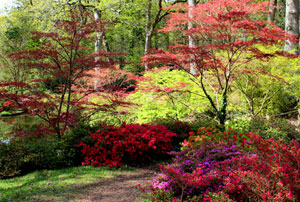
When it comes to adding plants to an oriental garden, nothing says Japan more than a large and delicate Japanese maple, with many, many different varieties of 'acers' being available, most of which belong to the 'acer palmatum' family.
Single and multi-trunked trees are equally popular, although you can probably expect to pay a little more for the latter.
Ideal Soil Conditions
Most Japanese maples are extremely hardy and will happily tolerate frosts, although they all have something in common - they prefer a soil that drains well. In fact, maples can suffer or even die if they are sitting in water during a wet winter.
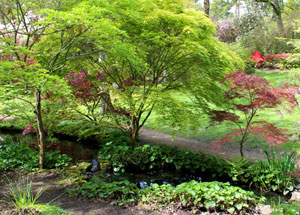
These plants tend to prefer an ericaceous soil (acidic), although they will tolerate neutral and even slightly alkaline soils, especially when they are well looked after. By adding plenty of organic matter and mulching well each year, the acidity of the soil can be increased if required.
Since their root systems are fairly shallow, acers welcome plenty of water and feeding during a hot summer, and if the soil dries out for long, the leaves may start to dry up. If this happens during the growing season, cut off any damaged leaves, ensuring that the leaf stalk remains intact (so that the bud at the base is not damaged). The tree will soon thank you with a set of fresh leaves.
If you are unable to plant your tree in the ground, then rest assured that maples respond well to container growing, benefitting from repotting and possibly root pruning every few years.
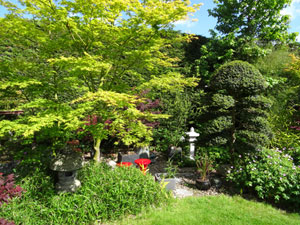
Full Sun or Shade?
Garden centres often state that Japanese maples require medium to heavy shade in order for them to thrive. However, most varieties will happily grow in full sun, even in a south-facing garden, as long as they are looked after properly and watered regularly. In order for a purple maple (such as 'acer palmatum atropurpureum') to have deep red / purple leaves, it requires a certain amount of sunshine, and if grown in heavy shade, the leaves will quickly become quite green or bronze.
If you have just purchased a maple tree that is used to a shady spot and then plant it straight out into strong sunshine, this new sunny position may ultimately result in scorching. It should therefore be gradually acclimatised to its new spot over several days.
There are, of course, some rather delicate species of maples that will not appreciate an exposed position, with many cultivars that feature finely cut dissected green leaves falling into this category. Acers such as these will benefit from a more sheltered spot, perhaps beneath the dappled canopy of a taller tree.
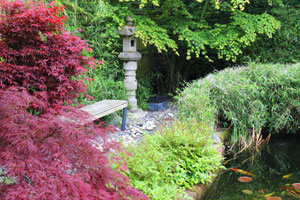
Characteristics and Seasonal Foliage Colour
When purchasing your Japanese maple, try to buy a large(ish) tree, since larger acers tend to be far more robust than small seedlings, which can soon die if mistreated. Factors to consider are not only size and shape, but also the colour of the leaves in the spring and autumn. Maples are renowned for their bright, fiery reds and oranges in the autumn, with 'acer palmatum osakazuki' putting on an especially reliable display of scarlet red leaves in the fall.
Other trees may boast yellow and paler orange foliage when the fall arrives, although for the very best autumn colour, a wet and sunny summer, as well as a frosty autumn, are certainly contributing factors. Some years, the autumnal colours of a certain acer tree will vary greatly, being yellow one year and then scarlet red the next. 'Deshojo' and 'Beni Maiko' varieties of acer palmatum are a good choice where spring colour is required, since their leaves emerge a shocking pink / red. This eye-catching spring colour can remain for several months, before the leaves finally turn green for the summer.
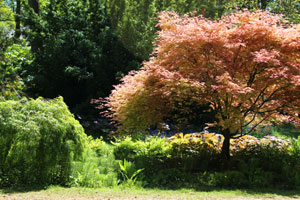
Propagation
Most 'fancy' varieties of Japanese maple are not strong enough to grow on their own set of roots and they are therefore propogated by grafting onto a vigorous 'acer palmatum' rootstock. Grafting is also necessary to keep varieties pure, as they don't tend to grow true from seed, with many variations when it comes to seedling leaf size, shape and colour.
Basic acer palmatum trees, including atropurpureum, can be propogated by seed, cuttings and air layerings of surprisingly large branches, which usually root adequately in just six or seven weeks.

Varieties
Popular varieties of Japanese maple (acer palmatum) include:
- Atropurpureum
- Beni Otake
- Bloodgood
- Burgundy Lace (dissectum)
- Crimson Queen (dissectum)
- Deshojo
- Fireglow
- Garnet (dissectum)
- Inabe Shidare (dissectum)
- Kashima
- Katsura
- Orange Dream
- Osakazuki
- Pink Filigree (dissectum)
- Red Pygmy
- Sango-Kaku
- Sango-Kaku / Senkaki (coral bark)
- Seiryu (dissectum)
- Shishigashira
- Shojo Nomura
- Skeeter's Broom
- Tamukeyama (dissectum)
- Trompenburg
- Viridis (dissectum)
Other varieties include:
- Acer Buergerianum (trident maple)
- Acer Davidii (snakebark maple / Pere David's)
- Acer Japonicum (downy Japanese maple)
- Acer Shirasawanum (fullmoon maple)
 When it comes to adding plants to an oriental garden, nothing says Japan more than a large and delicate Japanese maple, with many, many different varieties of 'acers' being available, most of which belong to the 'acer palmatum' family.
When it comes to adding plants to an oriental garden, nothing says Japan more than a large and delicate Japanese maple, with many, many different varieties of 'acers' being available, most of which belong to the 'acer palmatum' family. These plants tend to prefer an ericaceous soil (acidic), although they will tolerate neutral and even slightly alkaline soils, especially when they are well looked after. By adding plenty of organic matter and mulching well each year, the acidity of the soil can be increased if required.
These plants tend to prefer an ericaceous soil (acidic), although they will tolerate neutral and even slightly alkaline soils, especially when they are well looked after. By adding plenty of organic matter and mulching well each year, the acidity of the soil can be increased if required.


